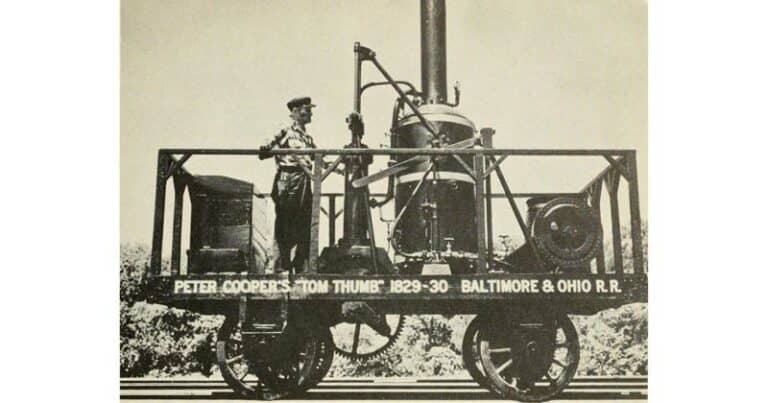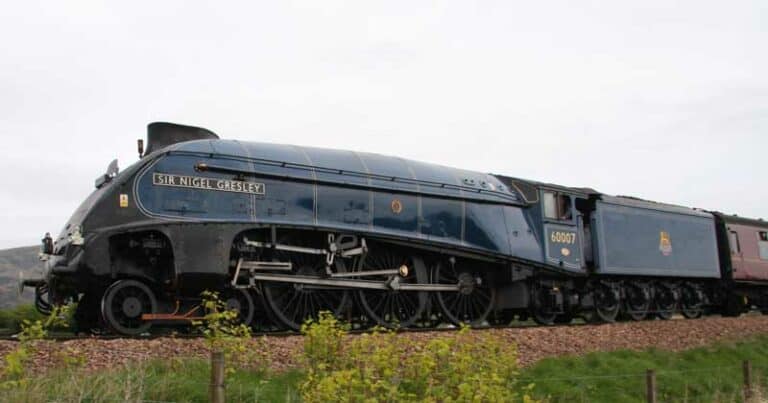John Bull, Oldest Operable Steam Locomotive
Several historic locomotives have seen replicas built, usually after the original was inoperable or scrapped. In the case of the John Bull, a British-made steam locomotive, a working replica was built while the original was still able to steam under her own power.

The history of John Bull includes several railroads, more than one World’s Fair and the Smithsonian – oh, and that record breaking run.
John Bull, Built in England, Bound for America

Built by Robert Stephenson & Co. in 1831, John Bull was built with an 0-4-0 wheel arrangement but would later be modified to 2-4-0 to allow for better steering and control. The locomotive first operated on the Camden & Amboy Railroad, the first railroad in New Jersey.
Many early steam locomotives had names attached to them. There weren’t that many steam locomotives in the country and it was quite an honor to have your name on a piece of brand new technology. At first this particular locomotive went by the name “Stevens” after Robert Stevens, the founder of the Camden & Amboy Railroad.
However, the locomotive’s British origins led her New Jersey crews to refer to her as ‘The Old John Bull’, a nod to the cartoon often used to depict Britain in human form (similar to Uncle Sam in the United States; Uncle Sam and John Bull are similar in that way).
When the Camden & Amboy Railroad purchased the locomotive in 1831, it was treated as almost a special attraction when it arrived. The railroad was not yet completed, but there was some track that John Bull could run on.
Getting to work in New Jersey
Steam locomotives were still very new, and while Camden & Amboy track was being laid between its namesake towns, politicians and celebrities got to take exciting rides behind the new locomotive. In an interesting and ironic turn, the railroad itself was completed by horse and cart.
Unlike most steam locomotives that we see or think of today, early steam locomotives – including the John Bull – were not powered by coal. John Bull was powered by wood. The shed that built on to the original flat car, the tender, and behind the overhang that served as a cabin for the crew, is where the wood was stored. Steam locomotives would generally be powered by wood until after the Civil War.

The railroad was finished in 1833 and John Bull, still named “Stevens” was finally working at her intended job. She was also assigned a number – number 1. It was indeed fitting number. A locomotive of firsts, the John Bull also became the first locomotive to operate in Harrisburg, Pennsylvania.
In September of 1836, the locomotive and two passenger coaches, her standard train, were loaded onto boats and shipped by canal to the Pennsylvania Capital. That showed the folks “out west” that a steam locomotive could indeed operate there. It would be the first of her ties to the Keystone state.
Steam locomotive development was rapid in those early years. In fact, the John Bull was part of the improvements. The first being the pilot truck, or “guide wheels” as the C&A called them added to the original 0-4-0 to make it a 2-4-0. Nearly steam every locomotive since, except switchers, have used pilot trucks.

Also added, and firsts, were the cow catcher, bell, headlight and the cabin for the operator. But what could not be added was more power. Pretty quickly larger, more powerful locomotives were introduced. After a relatively short life on the mainline, she was used in yard service.
Worse yet, the locomotive of firsts was eventually used a static boiler to power various machinery needs. Retired in 1866, the John Bull was put in storage.
Pennsylvania Railroad & Smithsonian to the Rescue
In 1871, the growing Pennsylvania Railroad acquired the John Bull. Well, in 1871 the Pennsylvania Railroad acquired the United New Jersey Railroad and Canal Company, which previously bought the Camden & Amboy. And so, the PRR became the owner of the John Bull. It’s a good thing.
A railroad the size of the Pennsylvania had no need for the meager scrap value, but they did see the public relations value of the John Bull. Coming up was the 1876 Centennial Exposition in the Penny’s corporate hometown of Philadelphia. What an opportunity!

A Big Crowd Draw on the Road
The locomotive was a massive hit at the Philadelphia exhibition so the PRR elected to move forward with a full restoration project that would bring John Bull back closer to its original appearance. After making more public appearances on behalf of the Pennsylvania Railroad, the locomotive was donated to the Smithsonian Institute in 1885.
Though the Smithsonian would be John Bull’s new permanent home, the locomotive made occasional appearances outside of the museum, including a famous run from New Jersey to Chicago for an appearance at the 1893 World’s Columbian Exposition (World’s Fair) in the ‘Windy City’.
Making her way back to the Smithsonian, she was placed on display there and with few exceptions – including one very notable exception – the John Bull has remained at the Smithsonian National Museum of American History.

The locomotive John Bull is given prominent position at the Smithsonian Museum of American History building in Washington, DC. If you go looking for her she is at the east end of the first floor lobby.
John Bull Gets a Replica
While John Bull was a crowd pleaser when making appearances, time began to take its toll on the locomotive. Concerns about the locomotive’s durability caused the Smithsonian to become leery of the travels away from the museum.
The 1939 World’s Fair was to be held in New York City, prime Pennsylvania Railroad territory, but the railroad agreed with the museum so decided to build a replica of the locomotive. Their Juniata shops in Altoona built an operational replica, based on the much modified later John Bull – with the larger stack and the crew cabin.

The operational replia was not ready in time for the opening of the 1939 World’s Fair, so – one more time – the original John Bull made a long trip. She was on static display in New York City for the first season of the Fair. The replica was ready for season two and took over for the original.
A big hit at the New York Word’s Fair, the Pennsylvania Railroad would showcase – and run – this replica at various events over the next few decades.
If you’re interested in seeing replicas of very early steam operating you might like the DVD, “1986 Steam Expo Vancouver“.
The replica would remain in storage while not being used at these public relations events. In the late 1960s the replica was donated to the Pennsylvania Historical and Museum Commission, and is now on display at the Railroad Museum of Pennsylvania.
Original and Replica are Retired…or are they…
Following her appearance at the 1939 World’s Fair, the original John Bull returned to Washington DC where the locomotive was placed on static display at the Smithsonian Institute’s East Hall. In 1964, the locomotive would be moved to the Smithsonian-operated National Museum of History and Technology. Now the National Museum of American History.
But those Smithsonian curators are crafty…in early 1980, they began planning for the locomotive’s upcoming 150th birthday – the following year. The locomotive was believed to be in decent shape, so several tests were conducted to test John Bull’s functionality. It was thought maybe they could run her on rollers via compressed air at the museum.
It turns out John Bull ran very, very well on the compressed air and so they brought in experts on steam pressure. The experts pronounced the John Bull safe and sound up to 50psi of steam pressure. Not bad at all considering she had been designed 150 years earlier for 70psi.
Confident that the locomotive could operate under her own steam power, the Smithsonian had the necessary restoration work done on the locomotive. In secret, a test run, on actual railroad tracks in Virginia was made. And… the sweet steam smell of success!
On a disused railroad branch line, within Washington DC, on September 15th, 1981, 150 years since her production, John Bull set the record for the world’s oldest operable/operating steam locomotive!

This was not a few feet of a run just to set the record. No, John Bull ran several miles that day. It was enough to claim both the oldest operable steam locomotive title and the oldest self-propelled vehicle in the world title.
John Bull Today
John Bull hasn’t turned a wheel under her own power since that day in 1981, but would you want to bet against her? She’s come back to life so often that a cat would be jealous.
An even earlier locomotive and another replica, check out the Tom Thumb, the first locomotive to run on the B&O!
Following the 150th birthday celebration, the original John Bull was returned to display at the Smithsonian – the nation’s premier museums of history and technology. To learn more about the Smithsonian National Museum of American History, go to their fascinating website; for the John Bull and their exhibit, they have a web page just for the steam locomotive.
And if you are Pennsylvania, you can visit the stuffed with steam locomotives Railroad Museum of Pennsylvania to see their well displayed replica of the John Bull. Like the original, the replica has occasionally gotten out of its comfort zone, notably in 1986 at the World Exposition in Vancouver, Canada for the Steam Expo.

Railfan and model railroader. Writer and consumer of railroad news and information.






